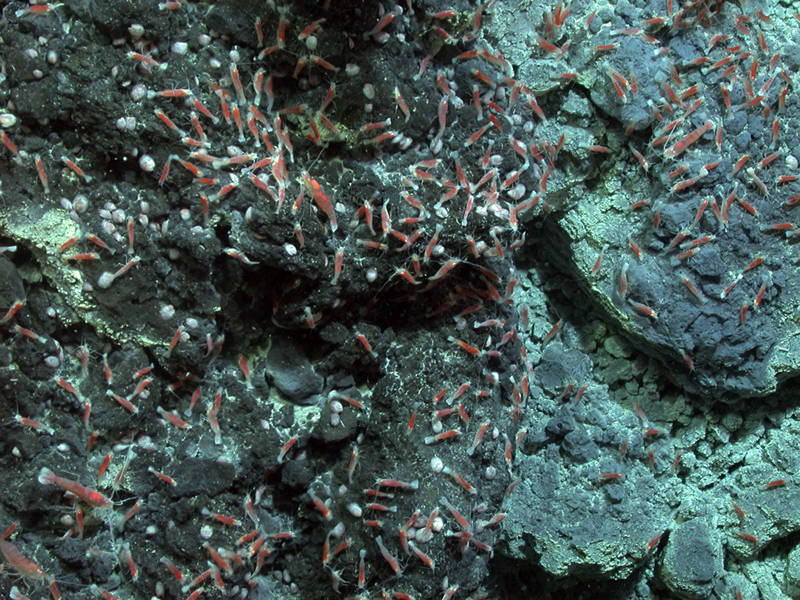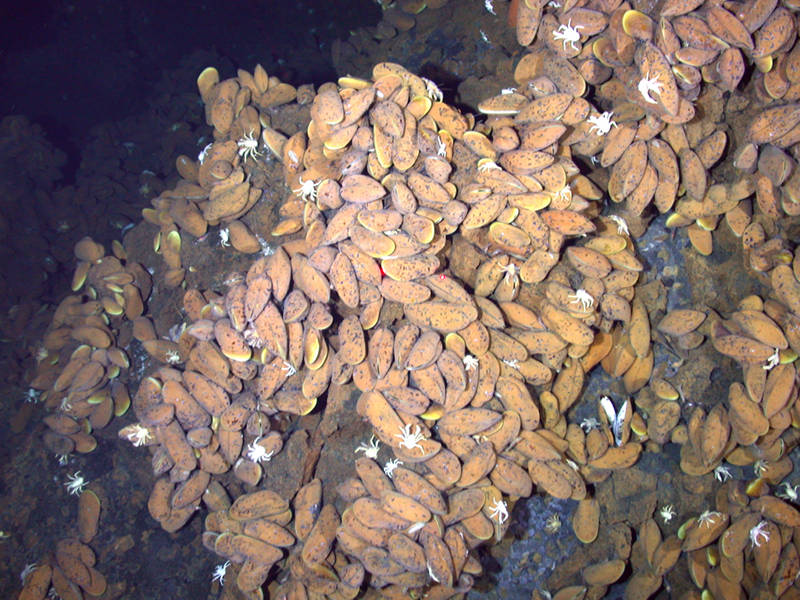
By Shawn Arellano - Western Washington University
Verena Tunnicliffe - University of Victoria
In few other places on Earth is animal nutrition as inextricably linked to microbes as they are at hydrothermal vents. Microbes have the ability to capture the chemical energy potential in hydrothermal vent fluids, thus growing without the need for sunlight. Vent fauna have evolved to take advantage of this abundant food source by forming mutualistic associations with bacteria, feeding directly on microbes, or using more complex trophic interactions fueled by microbes.
In other words, hydrothermal vents are island-like microbial smorgasbords that host dense oases of specialized macrofauna in an otherwise food-poor, dark, deep sea. But, to live at hydrothermal vents, animals must also face some serious challenges.
Ever since the hydrothermal vents along the Mariana Arc and Back Arc were first discovered and explored during the Submarine Ring of Fire Expeditions from 2003-2006, intensive interest has remained because these vents are closely spaced, yet diverse, in terms of tectonic setting, fluid chemistry, disturbance regimes, and faunal composition. This makes them a natural laboratory to explain how hydrothermal-vent animals deal with their extreme homes.

NW Rota 2010 landslide exposed new surfaces coated with sulphur where newly recruited shrimp and limpets congregate. Image courtesy of Submarine Ring of Fire 2014 - Ironman, NOAA/PMEL, NSF. Download larger version (jpg, 2.5 MB).
The vents along the Mariana Arc system are in different tectonic and volcanic settings. One site, NW Rota-1, is unique in that it is highly active. This may have a major impact on the local ecosystem because the volcanic activity can either create or destroy habitat.
In August 2009, a major landslide occurred that destroyed old, and created new, habitat. Observations in April of 2010 suggested that the populations of one of the site’s most common shrimp species, Alvinocaris sp., was nearly wiped out, while another, Opaepele loihi, was undergoing substantial new recruitment.
Observations at NW Rota have not been made since 2010 to assess how the two shrimp species have fared since the landslide. On this cruise, we will characterize the present geological setting and the benthic community to assess recovery since the 2009 landslide and document biological succession in this extremely dynamic geological environment.
Despite the active eruptive activity nearby, two species of shrimp thrive on NW Rota-1, because they are specifically adapted to this environment. Video courtesy of Submarine Ring of Fire 2006 Expedition, NOAA/PMEL. Download (mp4, 9.0 MB)
Although in relatively close proximity, on the order of 10 to 100 kilometers, vent sites along the arc host widely different and diverse animal communities, despite the potential for current-mediated transport of the larvae of these species between the vents. Biological mechanisms that favor short-distance dispersal and localized and rapid colonization of these volcanoes could explain the large variability among the sites in the composition of adult communities.
For sessile benthic marine species, there is a strong selection for their larvae to respond to cues that represent a quality environment for growth into an adult. Because of their reliance on microbes, the microbial environment may be a useful indicator of habitat quality for new settlers or colonizing juveniles of hydrothermal vent organisms.
For hydrothermal vent organisms with obligate bacterial symbionts, in particular, settlement preferences based on distributions of the free-living form of the symbiont may ensure the acquisition of their symbionts post-settlement. Microbial biofilms may signal to planktonic larvae that they have arrived at the right spot, thus inducing larval settlement, or to avoid a particular area for settlement.
On this cruise, we will be investigating the role of microbial biofilms in the early biological colonization and succession at these frequently disturbed hydrothermal vents, as well as the role of endosymbioses (symbiosis in which one of the symbiotic organisms lives inside the other) in structuring animals’ distributions around these volcanoes.

Eifuku mussel bed in 2006 where pH can be as low as 5.3. Image courtesy of Submarine Ring of Fire 2014 - Ironman, NOAA/PMEL. Download larger version (jpg, 2.3 MB).
Two of the vent sites we will visit, NW Eifuku and NW Rota-1, are known to have extremely high concentrations of carbon dioxide (CO2), with liquid CO2 and CO2 bubbles streaming from them. This high concentration of CO2 leads to local acidification at much more extreme levels than expected as a result of global climate change.
NW Eifuku hosts dense beds of mussels (Bathymodiolus brevior) whose shells are eroded and thin due to the acidity. Whether these mussels are in poor physiological condition due to the acidic environment is not yet known. One hypothesis is that even if the mussels are not in optimal condition, the lack of shell-damaging crab predators at this site allows these mussels to continue to live in this harsh environment.
We will be collecting mussels from these acidic vent sites on this cruise to determine whether the high-CO2 habitats cause marked physiological stress or whether these mussels are thriving in spite of their thin shells.
A dense community of chemosynthetic mussels lives in the harsh acidic environment around the Champagne vent field on NW Eifuku seamount. Video courtesy of Submarine Ring of Fire 2004 Expedition, NOAA/PMEL. Download (mp4, 4.9 MB)